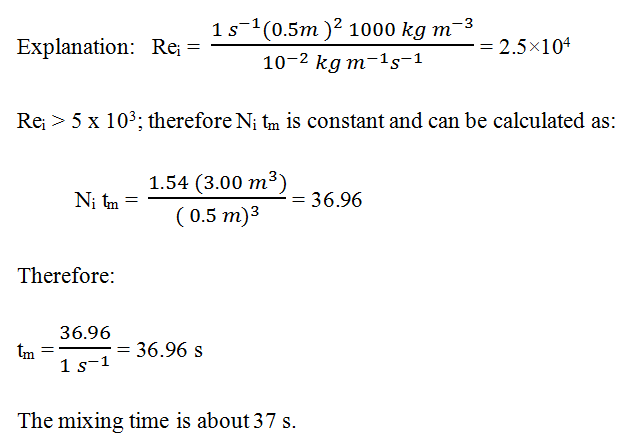This set of Bioprocess Engineering Multiple Choice Questions & Answers (MCQs) focuses on “Mixing”.
1. Which type of fermenter is used mainly for mixing?
a) Air-Lift fermenter
b) Stirred Tank fermenter
c) Fluidised Bed bioreactor
d) Packed Bed bioreactor
View Answer
Explanation: Mixing is usually carried out in a stirred tank; Stirred tanks are usually cylindrical in shape. If possible, the base of the tank is rounded at the edges rather than angled; this eliminates sharp corners and pockets into which fluid currents may not penetrate and discourages formation of stagnant regions.
2. What is the ratio of tank diameter to impeller diameter for Newtonian fluids?
a) 3:1
b) 2:1
c) 1:3
d) 1:2
View Answer
Explanation: Mixing is achieved using an impeller mounted in the tank; for use with Newtonian fluids, the ratio of tank diameter to impeller diameter is normally about 3:1. The impeller is usually positioned overhead on a centrally-located stirrer shaft. For efficient mixing with a single impeller, the depth of liquid in the tank should be no more than 1.0-1.25 times the tank diameter.
3. What is the width of baffle in order of the tank diameter used for mixing?
a) 1/5- 1/10
b) 1/12-1/15
c) 1/10-1/12
d) 1/5-1/12
View Answer
Explanation: The optimum baffle width depends on the impeller design and fluid viscosity but is of the order 1/10-1/12 the tank diameter.
4. “Pitch of a propeller”, Here what does pitch refer to?
a) Advance per resolution
b) Advance per rotation
c) Advance per Sharpness
d) Advance per revolution
View Answer
Explanation: Specification of the pitch of a propeller blade refers to its properties as a segment of a screw; pitch is the advance per revolution. In a propeller, the blade angle at each section is greater than the helix angle and, what is more important; the distance moved forward in one revolution (called the advance per revolution) is not by any means a fixed quantity.
5. Which is the most frequently used impeller in the fermentation industry regarded as 6- flat-blade disc-mounted turbine?
a) Propeller turbine
b) Rushton turbine
c) Bladeless turbine
d) Screw turbine
View Answer
Explanation: The Rushton turbine is a radial flow impeller used for many mixing applications (commonly for gas dispersion applications). The design is based on a flat disk with vertical flat blades vertically mounted.
6. “Rotational stirrers are advantageous for mixing”?
a) True
b) False
View Answer
Explanation: Simple circular flow of liquid around the shaft is generally disadvantageous and should be avoided. In circular flow, liquid moves in a streamline fashion and there is little mixing between fluid at different heights in the tank. Circular flow also leads to vortex development. At high impeller speeds, the vortex may reach down to the impeller so that gas from the surrounding atmosphere is drawn into the liquid; this is generally undesirable as it produces very high mechanical stresses in the stirrer shaft, bearings and seal. Prevention of circular flow has a high priority in design of mixing systems, and is usually achieved by installing baffles which interrupt the circular flow pattern and create turbulence in the fluid.
7. Are Propellers and Impellers different in function from each other?
a) True
b) False
View Answer
Explanation: Propellers commonly refer to devices which move an attached object. For example, a ship’s propeller moves the ship itself forward or backward. Impellers, on the other hand, are designed to move the substance — fluid or gas passing through it without moving the object it is attached to.
8. Mixing is sufficiently done away from the impeller?
a) True
b) False
View Answer
Explanation: Near the impeller there is a region of high turbulence where fluid cur- rents converge and exchange material. Away from the impeller, flow is slower and largely streamline; mixing in these regions is much less intense than near the impeller.
9. Which of the following is the slowest step in mixing process?
a) Distribution
b) Diffusion
c) Dispersion
d) Decomposition
View Answer
Explanation: Distribution is an important process in mixing, but can be relatively slow. In large tanks, the size of the circulation paths is also large and the time taken to traverse them is long; this, together with the regularity of fluid pumping at the impeller, inhibits rapid mixing. Accordingly, distribution is often the slowest step in the mixing process.
10. In the following equation, what does “λ” Represents for the formed eddies?
\(\lambda = (\frac{v^3}{\epsilon })_{1/4}\)
a) Wavelength
b) Kinematic velocity
c) Viscosity
d) Dimension
View Answer
Explanation: The degree of homogeneity possible as a result of dispersion is limited by the size of the smallest eddies which may be formed in a particular fluid. This size is given approximately as the Kolmogorov scale of mixing, or scale of turbulence, λ, where λ is the characteristic dimension of the smallest eddies, v is the kinematic viscosity of the fluid, and ε is the local rate of turbulent energy dissipation per unit mass of liquid.
11. A fermentation broth with viscosity 10-2 Pa s and density 1000 kg m-3 is agitated in a 3.00 m3 baffled tank using a Rushton turbine with diameter 0.5 m and stirrer speed 1 s-1. Estimate the mixing time.
a) 37 s
b) 33 s
c) 35 s
d) 39 s
View Answer
Sanfoundry Global Education & Learning Series – Bioprocess Engineering.
To practice all areas of Bioprocess Engineering, here is complete set of 1000+ Multiple Choice Questions and Answers.
If you find a mistake in question / option / answer, kindly take a screenshot and email to [email protected]
- Check Biotechnology Books
- Apply for Biotechnology Internship
- Check Bioprocess Engineering Books
- Practice Biotechnology MCQs

